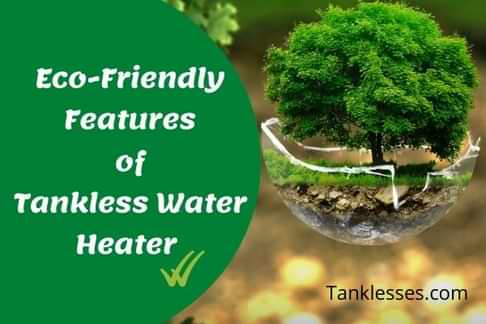A tankless water heater provides hot water only when the owner commands it. It uses energy on demand to heat the water not to store and preserve. So, it does not produce standby energy losses, unlike the storage water heater. On many points, a tankless water heater comes off as an eco-friendly product that helps us to protect the greens for a better environment.

Green Features of Tankless Water Heaters
Energy saver/ Green tech:
One of the most important things one can do for the environment is to save energy, especially the type we get from fossil fuels. The manufacture and distribution of fossil fuels alone are bad for the atmosphere, and not to mention, continually burning these nonrenewable resources is unsustainable. Reducing reliance on greenhouse gas is a crucial step to mitigate climate change and preserve our limited resources, and using tankless water heaters does just that.
It is quite obvious that people will have varied opinions about energy saving, depending on their household usage. However, in the case of energy savings, tankless water heaters can be as high as forty percent. This amount of energy-saving nearly cuts a person’s bills in half.
If one is looking for a sustainable option between the tankless water heater and storage water heater, the choice is really obvious. Tankless water heaters are sustainable at every step of the supply chain. Storage water heaters, on the other hand, not so much. Tankless water heaters are much more environment-friendly, to begin with. Even their manufacturing seems to consume fewer resources than that with storage. Also, people need fewer resources to set it up.
Work efficiency:
Storage water heaters are vastly inefficient when their energy usage is taken into consideration. They consistently use double the electricity that a tankless water heater would use because the machines experience standby heat loss. This happens when warm water is called on but never used. After the system heats the water, it slowly starts growing tepid hour by hour just sitting there. Then when the owner wants hot water again, it uses even more energy to make it happen. In short, it simply doubles the amount of energy the owner would usually use.
Electric tankless water heaters stop excessive energy consumption in its track by getting rid of the tank. Water is heated by thermal optic sensors that activate when water passes through, which heats the water on demand and avoids the inefficient process of having to reheat the water.
Less waste:
According to the data provided by the World Bank, the whole world averages about 22 metric tons of carbon dioxide emission per capita within the years 2011 to 2015. Usually, industries are the ones to blame for the most part. However, citizens are also partially responsible for this. They often do not know what they do is wasteful. Those who use a storage water heater leave behind prominent carbon footprints due to double energy usage. A tankless water heater is more reliable in this regard. In a comparison of these two, a tankless water heater undoubtedly emits less carbon dioxide.
Tankless water heaters tend to have a lifespan that is double that of a storage water heater. Replacing water heaters constantly takes a toll on the atmosphere. The metal can easily leach into the dirt. But with tankless water heaters, these problems are kept to a minimum.
Compact design:
Tankless water heaters heat water straightforwardly without the utilization of a capacity tank. When you turn on a high temp water tap, chilly water goes through a line into the unit. Either a gas burner or an electric component warms the water. Subsequently, tankless water heaters convey a consistent flexibly of high temp water. You don’t have to sit tight for a capacity tank to top off with enough boiling water. Notwithstanding, a tankless water heater’s yield restricts the stream rate.
Ordinarily, tankless water heaters give boiling water at a pace of 2–5 gallons (7.6–15.2 litres) every moment. Gas-terminated tankless water heaters produce higher stream rates than electric ones. Now and again, notwithstanding, even the biggest, gas-terminated model can’t flexibly enough high temp water for concurrent, various utilizations in huge family units.
For instance, washing up and running the dishwasher at a time can extend a tankless water heater as far as possible. To solve this issue, you can introduce at least two tankless water heaters, associated in equal for concurrent requests of high temp water. You can likewise introduce separate tankless water heaters for machines -, for example, a garments washer or dishwater – that utilization a ton of high temp water in your home.
The reduced planning of this particular item tankless water heater is 90% more modest than a tank-type heater, permitting you to put them nearly anywhere. Because it is so little and can be introduced at the purpose of utilization, so you don’t need to squander water trusting that your water will warm up.
Tankless water heaters can last more than 20 years, any longer than some other water heater. Tanks last 10-12 years.99.8% warm energy proficiency. Most water heater tanks are just 65% effective. Warms water when you need it, rather than keeping hot water day in and day out. Sparing energy diminishes your carbon impression.
Conclusion:
Appropriate establishment and support of your interest water heater can enhance its energy effectiveness. Legitimate establishment relies upon numerous variables. These components incorporate fuel type, atmosphere, neighbourhood construction regulation prerequisites, and wellbeing issues, particularly concerning the burning of gas-terminated water heaters. Subsequently, it’s ideal to have certified pipes and warming contractual workers introduce your interest water heater.